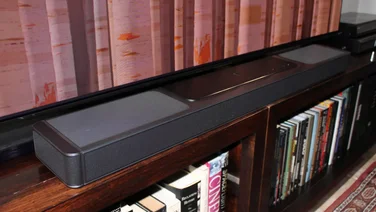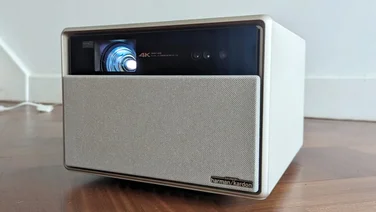To help us provide you with free impartial advice, we may earn a commission if you buy through links on our site. Learn more






- Big bass, clean dialogue
- True Dolby Atmos height channels
- Simple setup, seamless integration
- Heavy bass needs a leash
- Narrow soundstage for music
- No physical buttons or visible UI
Sony isn’t going for subtlety with the Bravia Theatre Bar 6. Straight-faced and built to boom, this Dolby Atmos soundbar system is designed for folks looking to add tangible slam to their evening viewing.
At £499, this soundbar stands as Sony’s most accessible offering in its growing Bravia Theatre line. It’s home cinema without pretension, engineered not for audiophiles, but for families, streamers, and movie fans who want nothing more than a significant upgrade on their TV’s built-in speakers, without having to navigate the usual AV equipment maze.
It’s basically plug & play, with no additional calibration to worry about. Of course, simplicity often comes with compromise, so caveats are inevitable.
The channel designation is 3.1.2, which immediately tells us no rear speakers are provided. For that, you’ll need to step up to the Bravia Theatre System 6.
What Do You Get for the Money?
For £499 you get a soundbar (the HTB-600) that measures 950 x 110 x 64mm (WDH), suitable for televisions between 50in and 65in. It weighs 3.1kg, which is light enough to wall mount without undue effort, and it comes partnered with a large, wireless subwoofer (the SA-WG700) that stands tall at 210 x 388 x 388mm (WDH) and weighs 7.7kg.
The bar is a five channel unit that has two upward-firing drivers, a centre channel driver, and left/right array. The subwoofer is ported to the rear and, like the soundbar, has a non-removable grille. The whole thing looks smart, with the soundbar finished in a non-reflective matte black.






A simplified remote control takes care of the basics: volume adjustment, input selection, bass adjustment and Sound Field selection. You can assign one of three post processing modes to the latter, via the accompanying Bravia Connect app: Sony’s Vertical Surround engine, Dolby Virtualiser, or DTS Neural X.
All can be applied to stereo content to create a more immersive listening experience. It’s a matter of taste as to what’s best, but I settled on the Vertical Surround Engine, mainly because it was the most consistent.
The remote isn’t solar powered, which seems a shame, but the the AA batteries you need for it are supplied in the box, along with power cords. And you don’t need extra hardware to wall-mount it, either, as there are keyhole mounting points included on the rear of the bar.
What does it do well?
Movies are where the Bravia Theatre Bar 6 excels. Punchy and exciting, it moves sounds around with gusto and applies bass with a trowel. For action-oriented content, this approach works well.
Arcane: League of legends, on Netflix (Dolby Atmos) is a sonic tour de force. The episode one opener illustrates just how well the bar handles a wide dynamic mix, locking vocals cleanly to the centre channel, leaving the flaming buildings and general destruction, to add width and height.






The subwoofer, when not going completely rogue, contributes plenty of low-frequency effects and shakes deep and often. Fantasy movie, Kong: Skull Island (Dolby Atmos) opens with a scuffling fight between two World War II combatants; their fight is halted dramatically by a huge rumble from the great ape himself. The system provides enough weight to suggest said ape is actually rising from behind the telly.
But with more everyday fare, this same bass balance seems heavy handed, often adding ponderous weight where none is required. You can manually reduce the contribution of the subwoofer, but this never quite solves the problem.
Dialogue clarity is excellent, however, thanks to the centre channel and Sony’s highly efficient X-Balanced speakers. Whether it’s a child’s lullaby or Max Rockatansky’s growl, voices are crisp, clear, and rarely buried under effects.
What could be improved?
The subwoofer’s crossover with the soundbar is set quite high – at 200Hz – which means it’s localisable (you know where it’s placed) and omnipresent. Taming it without neutering it is tricky.
Not having on-body controls or an on-soundbar user interface is also a frustration. You’ll need the Sony app, which I found a little flaky and unstable, to access some features, like choosing that post-processing mode.






And, last but by no means least, music played on this system sounds narrow and dense. The soundbar’s stereo drivers are close to each other physically, and consequently so is the perceived sonic spread. I tried a variety of musical genres (pop, rock, classical), and found its forward-facing presentation and heavy bias often difficult to live with.
It’s also worth noting that there’s no Wi-Fi streaming support, so there’s no support for Spotify Connect, Apple AirPlay or similar.
Sony Bravia Theatre Bar 6 review: Should you buy it?
If your movie nights are marred by the hollow clatter of built-in TV speakers, and you’ve been thinking of dipping your toes into the Dolby Atmos pool with something living room friendly, the Bravia Theatre Bar 6 can be considered a sound choice.
It’s a straightforward home cinema upgrade if you yearn for action movie bombast; overall, I’d rate it an energetic, often exciting listen.
It’s also a combo that’s prone to over-blowing bass and isn’t particularly great with music playback. But, given its mid-range price, the Sony Bravia Theatre bar 6 remains worth an audition.













